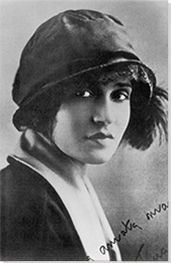Summary of Tina Modotti
Tina Modotti was a captivating personality from whom creativity effortlessly flowed. She was destined to be at the center of important historical change, not only as a photographer, but also as a sought-after model, a famous film actress, and a key political activist. It has been said that her career divides neatly in two, the first half inspired in particular by her relationship with the American photographer Edward Weston and their shared exploration of Straight Photography. The latter half of Modotti's oeuvre - apparently by contrast - is considered dominated by the artist's love for Mexico and the growth of her passionate Communist beliefs. However, on close inspection it seems more accurate to assert that all of Modotti's recurring interests - in the floral, repeated pattern, the depiction of the working classes, and of indigenous culture - were animated having left Europe and America, and bare homage to Mexico. Unlike other photographers who retreated into pure aesthetics during times of conflict, Modotti threw herself head first into contemporary politics and into real, often dangerous action; hers was a total and highly intellectually charged art that unfortunately dwindled in production as she was summoned to protest.
Accomplishments
- Comparable to other iconic Straight Photographers of her generation, Modotti's pictures privilege sharp and highly defined close-ups, and reveal an inexhaustible interest in underlying geometrical pattern, both manmade and present in nature. In this respect, her body of work is as notable and seminal to the movement as the likes of images made by Paul Strand, and Ansel Adams, and Edward Weston.
- Perhaps in some respects more in tune with the ideology of the Hungarian-American photographer, Laszlo Moholy-Nagy, Modotti was more liberal and defiant of photographic convention than some of her contemporaries working with the new medium. She often used the technique of cropping, and was more experimental in her choice of perspective than other Straight Photographers. As such her body of work is also interesting when aligned with the movement of Surrealism.
- Modotti's recurring interest in the subject of flowers and in still-life likens her career to those of Imogen Cunningham, Georgia O'Keeffe, and Frida Kahlo. The flower for all of these women was a subtle assertion of female sexuality, and not only a nod to the theme of mortality and the transience and fleeting nature of life, but also paradoxically an attempt to capture life and give it duration beyond its natural cycle. Both Modotti and Kahlo successfully subverted the seemingly innocent motif of still-life as means to convey powerful and revolutionary messages.
- As well as being a practicing artist, Modotti was also an active political activist, possibly even a Soviet spy (bearing witness to political crimes and an assassination). Ultimately she was deported from Mexico labeled as an enemy of the state, and in this respect, unlike her fellow artists, had in many ways sacrificed her art in the name of her political beliefs and the fight for Communism.
Important Art by Tina Modotti
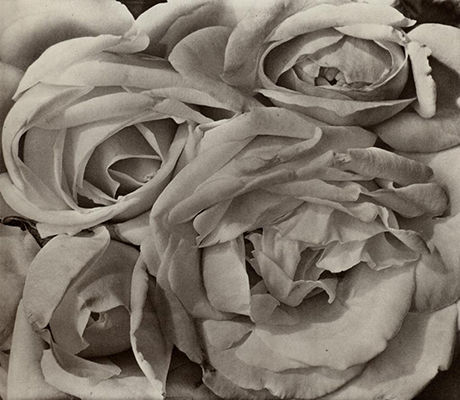
Roses, Mexico
Roses, Mexico, is an extreme close-up of four roses. Cropped to fill the frame from edge to edge, this is not a traditional still-life photograph of roses arranged in a vase. Here, the roses lay prone and slightly wilted, just beyond their prime, thus reflecting the passage of time and the ephemerality of delicate blooms. Much like a traditional vanitas still life that asked the viewer to contemplate mortality by reflecting on the fleeting nature of material objects, Roses brings this subject to modern photography. As photography historian Carol Armstrong notes, Roses "calls on the line of figural abstraction identified, not with [Alfred] Stieglitz, [Paul] Strand and the 'straight' photograph, but with Georgia O'Keeffe and her blown-up genital flowers, which like [Edward] Weston's single-object photographs reduced the flora still-life that had been the traditional purview of the female painter to one (or two or four) item(s), expanded to fill the entire field of the image."
The theme of the still-life preoccupied Modotti throughout much of her brief photography career. A relative newcomer to photography, she made use of the still-life photograph as a means to work through various formal issues including composition, framing, light, pattern, and tone. At this time, she was working with a large-format camera, which was unwieldy, not easy to transport, and forced the photographer to carefully compose the image, rather than creating images on the move with a handheld camera. The still-life, which was easy to set up and did not alter, was the perfect vehicle for mastering the myriad technical complexities of a photograph.
Not only holding a mirror to the similar close-up flower paintings by Georgia O'Keeffe, Modotti's flower paintings also bare interesting comparison to the oeuvre of Imogen Cunningham, a fellow photographer with shared interest in both the subject of botany and in hands (as seen in Modotti's later puppeteer series).
Palladium print - The Museum of Modern Art, New York
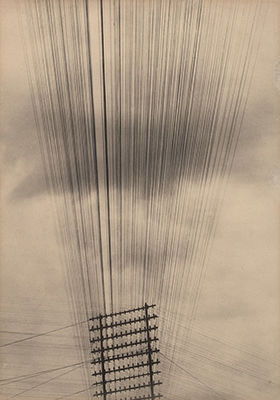
Telephone Wires, Mexico
In this 1925 photograph of isolated telephone wires, Modotti shifts the perspective, removing any reference to the ground that holds the telephone poles in place. Instead, the carefully composed image focuses on the angles and patterns produced by the wires and clouds, to create a work that mingles modernism and social concerns. During this period Mexico was undergoing increased modernization and industrialization, which Modotti symbolizes in her photograph of telephone wires. Modotti thus presents an optimistic view of Mexico's modernization and the promise of instant communication brought about by the installation of telephone systems that seemed to open up Mexico to the rest of the world.
Lauded by the Mexican avant-garde group, Estridentistas, who aligned their work with the Mexican Revolution and sought to modernize Mexico, Modotti's photograph was included in their journal Horizonte because it represented dynamism, technology, and progress. The photograph's framing and its use of oblique angles and unusual perspective, brought it into alignment with other modernist painters and photographers, including Paul Strand, Charles Sheeler, and Charles Demuth, but also with European avant-garde photographers like László Moholy-Nagy, Man Ray, and Albert Renger-Patzsch. Although the tendency to focus on the subject/object was characteristic of her former mentor Edward Weston's work, Diego Rivera praised Modotti's work as "more abstract, more ethereal, and even more intellectual" than Weston's.
Palladium print - The Museum of Modern Art, New York
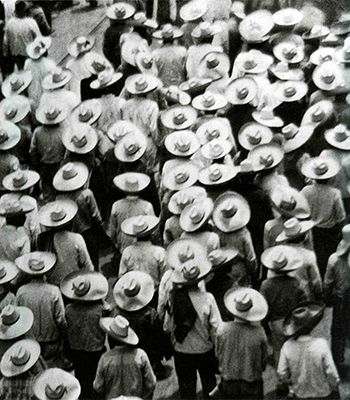
Workers Parade
A closely cropped image of a sea of sombreros, Workers Parade, much like her earlier photograph Roses, focuses in on the subject by eliminating all extraneous information. The politically charged subject matter, along with the unusual camera angle, attention to light and dark, and the texture and pattern produced by photographing the scene from above recalls the slightly later work of Alexander Rodchenko, and in particular, his Gathering for a Demonstration (1928). The ubiquitous sombrero would have been immediately recognizable to the Mexican viewer for its connection to the campesinos and trabajadores, the Mexican workers, who were gathered for the annual May Day parade in Mexico City. May Day, traditionally celebrated on the first of May, commemorates International Workers' Day, often with large parades and gatherings as a demonstration of solidarity among workers. This was a calendar event that Modotti had been familiar with since childhood due to her father's involvement in these very same parades.
Among Modotti's earliest politically motivated photographs, Workers Parade brings together her formal concerns with her interest in using art to express her political beliefs and her desire to make her photography socially relevant. On a symbolic level, as noted by Sarah Lowe, Worker's Parade conveys the power of unity by "suggesting that the source of power to make political changes lies with the peasants." This photograph signaled a turning point in Modotti's work toward a new modern form of photography that addressed contemporary issues and events in order to instigate and effect change.
Gelatin silver print - The Museum of Modern Art, New York
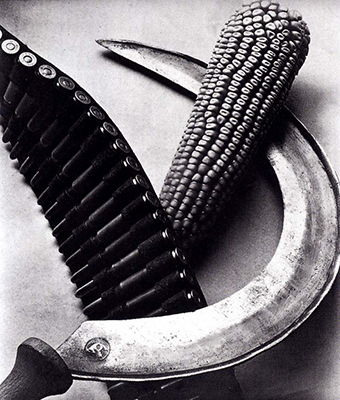
Bandolier, Corn, Sickle
A carefully composed photograph of a bandolier, an ear of corn, and a sickle, married Modotti's interest in the photographic still life with objects symbolic of Mexico and the revolution - the sickle, a popular Communist symbol, corn, a symbol of Mexico and its rural farmers, and the bandolier (a pocketed belt for holding ammunition), the symbol of the Mexican Revolution. Politically active after 1925, Modotti joined the Communist Party of Mexico (CPM) in 1927. Due to her Communist-inflected worldview, her photographs from the late 1920s took a decided turn toward Communist symbolism, in lieu of overt propaganda.
As Sarah Lowe has stated, "her eloquent arrangements - founded on a stringent formal control - relocates the commonplace into the realm of the symbolic. They become potent revolutionary icons, offering a metaphorical union of artista [artist], campesino [farm laborer], and soldado [soldier], thus functioning as both formal still life and propaganda." Lowe further suggests that in so doing, Modotti created a new kind of political picture. In this respect, Modotti's relationship with Frida Kahlo becomes more than a shared friendship, and also incorporates shared artistic practice. Kahlo also infused still-lives with political objects and slogans, and as such transforms a seemingly domestic process of making art into a highly charged political statement.
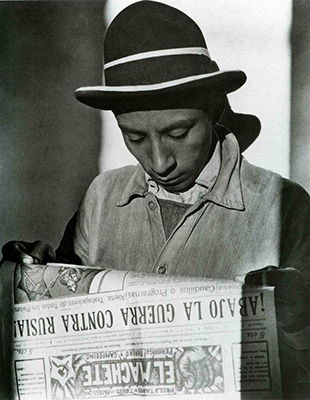
Peasant Reading El Machete, Newspaper of the Communist Party
In this photograph of a peasant reading El Machete, the newspaper of the Mexican Communist Party, Modotti brings her careful attention surrounding composition, cropping, light and dark, and texture, to a subject with great social and political significance. Modotti had joined the Communist Party of Mexico this same year after learning that Italy had fallen to fascism. She brought her revolutionary zeal to her photographs of the late 1920s, many of which she published in Communist newspaper El Machete, a newspaper for workers and peasants. Whilst many photographers of this period, including Edward Weston and Paul Strand, were focused on a romanticized view of a timeless Mexico, Modotti turned to her camera to its people and to the real effects of its ongoing changes. She often collaborated with workers to produce photographs that were intended to raise class-consciousness and depict their daily lives.
At a moment when new governmental education reforms sought to educate the lower and working classes in Mexico, a seemingly straightforward image of a man reading a newspaper also had subversive undertones, particularly to the middle class. As Sarah Lowe notes: "The young obrero reading El Machete is a reminder that the Revolution's promise of universal literacy would only be fulfilled by the activism of the people." Although she viewed photography through the lens of modernism, she also believed that photography was a form of mass communication and an important means of enhancing visual literacy.
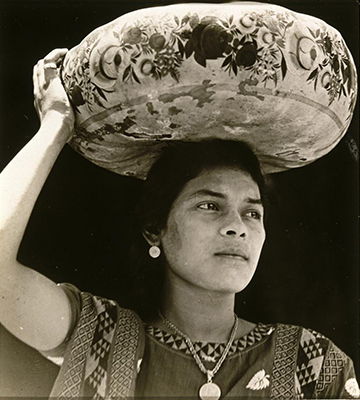
Woman from Tehuantepec
In this iconic black and white photograph, a woman dominates the picture frame. Standing with arm raised holding a large gourd on her head, she gazes off to the right, somewhere out of the picture frame. She wears a circular pendant and earrings, and a traditional Tehuana dress with geometric patterns, the costume that has been so well made visible by the work of Modotti's friend, Frida Kahlo. The careful framing, cropping, and pose emphasize the image's angular forms. Shot from below to emphasize the woman's noble and heroic stature, the photograph was taken during a trip to Tehuantepec in Southern Mexico. Unlike Modotti's earlier photographs, the photographs taken in Tehuantepec were largely unposed, typically street photographs that captured the daily lives of the women that lived there.
Like other artists and writers in Mexico, Modotti was influenced by Mexicanidad, which embraced native cultures and indigenous subjects as part of the larger renewal in Mexican art and culture in the 1920s. This interest is evident in Woman from Tehuantepec. One of Modotti's most iconic images, it became a potent symbol of Mexicanidad and an exercise in photographic modernism. As Sarah Lowe has noted, "the image function[s] like still life, precisely because Modotti chose not just any woman, but a well-known Mexican type - the Tehuana - to photograph. As pictured by Modotti, these women of Tehuantepec were an ideal subject, and provided her with an already-given meaning since Tehuantepec is a matriarchal society, there women have a significant voice in the running of the local economy and politics. Modotti uses the Tehuana to make a powerful political point: that women were capable of independent political action."
Gelatin silver print - The Philadelphia Museum of Art
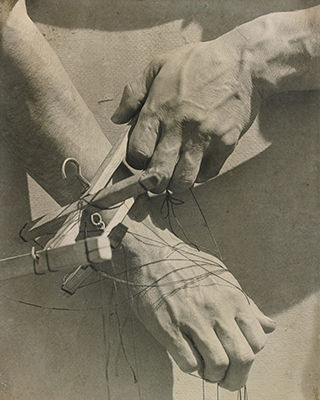
Hand of the Puppeteer, Mexico City
A closely cropped black and white photograph of two hands holding a puppet's strings, Hand of the Puppeteer makes dramatic use of light and shadow, textural contrasts, and isolation of the subject, to produce a carefully composed image that resonates with symbolism. As in her other photographs from this period, Modotti combined the formal rigor typical of modernist photography with her interest in using photography for the betterment of society. Like her avant-garde contemporaries, László Moholy-Nagy for example, Modotti believed that photography was a democratic medium with the power to reach, and ultimately educate, the masses.
Hand of the Puppeteer is part of a series of photographs Modotti made in 1929 on artists at work. In this instance, she photographed the puppet theater of Lou Bunin, an American artist who was invited to Mexico by Diego Rivera to work as his apprentice. A friendship developed between Modotti and Bunin, who shared interests in the theater and the belief that art should reflect contemporary reality. According to Sarah Lowe, "Bunin . . . had found marionettes an effective means of social commentary." Bunin used puppetry as a means of educating a largely illiterate public. Bunin's use of puppets was also a political metaphor. In this context, according to Lowe, "The puppet controlled from above is a metaphoric description of the asymmetrical power relations between those governing and those governed, a perceptive comment upon the social and political conditions in Mexico in the 1920s, and perhaps on Mexico's relationship with the United States at the time." Hands of the Puppeteer is emblematic of Modotti's belief that through the use of metaphor and symbolism, photography could awaken class-consciousness in the viewer.
Indeed, in this images the strings appear cut and/or broken, as though making comment that the time to be utterly controlled by governing powers above is over. Similar to the Telephone Wires, strings that are usually attached are being dethatched and set free. Furthermore, the subject of hands is one that recurs regularly and interestingly, often within the movement of Surrealism. Hands were included in Man Ray's early "Rayographs", as well as in notable works by Dora Maar and Claude Cahun, and as such the view and treatment of this subject widens the reach of Modotti's career beyond Straight Photography.
Gelatin silver print - Minneapolis Institute of Art
Biography of Tina Modotti
Childhood
Tina Modotti was born Assunta Adelaide Luigia Modotti Mondini, and given the nickname Assuntina, a diminutive of her mother's name, later shortened to Tina. She was the third of six children born to Giuseppe Modotti and Assunta Mondini, and the family lived in the Northeastern Italian town of Udine, at the base of the Austrian Alps. Although the historic town of Udine was prosperous and in general politically conservative, the working classes tended toward Socialism and political activism. Modotti's father was among those influenced by such activism; he often attended demonstrations and meetings, including the May Day demonstrations that took place every year. The family moved, and Modotti spent much of her childhood living in Austria, where her father worked as a mason, and her mother stayed home with the children working as a seamstress to generate additional income. In 1905, the family returned to Udine and Modotti left school to work in a textile factory. Although she seems to have had little exposure to art as a child, her uncle Pietro Modotti did run a successful photography studio (and school), where she may have worked as a teenager.
Also in 1905, Modotti's father Giuseppe emigrated to the United States by way of New York. In 1907 he moved to San Francisco, where he opened a photography studio in North Beach, the Italian hub of the city. In June of 1913 Modotti traveled to New York, then on to San Francisco to join her father and sister. After her arrival in San Francisco, Modotti worked odd jobs in the city's garment industry. In the mid-1910s she met Roubaix de l'Abrie Richey (known as Robo to his friends), an American bohemian painter and poet, who had a profound influence on Modotti's early artistic life. Through Richey, Modotti was introduced to the artists, writers, photographers, and other members of the cultural elite, including the prominent photography critic Sadakichi Hartman. By 1917 she was appearing as an actress on the theater stage, perhaps at the encouragement of Richey. Her path to the stage seems to have come by way of her flair for reciting poetry and her ability to captivate audiences. By age 26, Modotti had become a minor celebrity in the Italian community of San Francisco.
Modotti is said to have married Richey in Santa Barbara in 1918, though there is some speculation that the two were never legally married. They moved to Los Angeles later that year. In Los Angeles Modotti worked in theater and film. She also worked as a much sought-after model for artists and photographers, including for the notable Pictorialist photographer, Jane Reece. In 1920 and 1922 she secured several film Hollywood film roles. During their time in Los Angeles Modotti and Richey enjoyed a wide circle of friends that included writers, artists, actors, dancers, and musicians. They hosted frequent parties where the couple probably met photographer Edward Weston, who was running a portrait photography business in Los Angeles. Modotti modeled for Weston for the first time in 1921.
Early Training and Work
Modotti stayed behind in Los Angeles, and Robo Richey left for Mexico in late 1921. With the promise of both a job and a studio, Richey planned to paint and to soak up the highly charged political atmosphere of 1920s Mexico City. His time in Mexico was tragically brief however, as he contracted small pox only a few months later and died in February 1922. In the wake of Robo's death (arriving just two days late to be able to say a personal goodbye), Modotti traveled to Mexico and spent time with his closest acquaintances, including Ricardo Gómez Robelo, who had recently become the Chief of the Education Ministry's Department of Fine Art.
The people that Modotti met while in Mexico during 1922 influenced her decision to move there the following year. Devastated by the loss of Richey, but also by the death of her father, who died just a few months after Richey, she returned to Los Angeles and developed a close personal relationship with the already famous photographer, Edward Weston. Weston, who has since been credited as one of the most influential American photographers of all time, at this moment had an active studio in Los Angeles, and was married with children when he and Modotti became lovers. By the end of 1922, Modotti had decided to leave her acting career behind and to travel with Weston to Mexico to learn photography and make a new life.
When they arrived in Mexico in 1923, Modotti was resolutely committed to becoming a professional photographer. In the 1920s, following a decade of hostilities after the 1910 Revolution, Mexico was experiencing a period of relative calm, increased modernization, and a renewal in the arts that included ambitious new cultural policies combining social and educational initiatives. As a result, Mexico City became a cultural center that lured many artists and intellectuals throughout the 1920s. It was in this optimistic atmosphere that Modotti and Weston opened a photography studio in September of 1923 and planned to run it together.
Modotti began taking photographs around this time, many of which incorporated close-up images of flowers and other still-life compositions. She hoped that learning photography would allow her to become financially independent, and while she initially served as Weston's darkroom assistant, she also participated actively in all other aspects of running the studio. From 1923 to 1930 she was able to support herself as a professional photographer. At this time, Modotti and Weston met and socialized with other artists and revolutionaries, including Dr. Atl (Gerardo Murillo Cornado), Nahui Olín, Diego Rivera and his wife Guadalupe Marín, Ricardo Gómez Robelo, painter Xavier Guerrero, painter Rafael Sala, and French painter Jean Charlot.
After setting up their studio, the photographer couple spent time touring Mexico City and the surrounding area, primarily visiting ruins. In April of 1924 Modotti and Weston, along with a group of friends, spent a week photographing at Tepotzotlán, the ancient Mexican town just north of Mexico City. Early on Modotti worked with a 4 x 5 inch view camera that required a tripod. This machine was well-suited to formal portrait sittings and for documenting murals, which she often did after 1926. A few years later, Modotti purchased a Graflex, a handheld single lens reflex camera that provided her with greater spontaneity and freedom of movement because it did not require a tripod. Like Weston, she subscribed to the importance of composing images in the camera. She often contact-printed her negatives, which meant that the paper was placed directly on the negative and exposed to light. Although many photographers from this period came to Straight Photography through Pictorialism (an emulation of painting using photography), Modotti completely bypassed earlier movement in favor of the "straight" approach.
Mature Period
Whilst Weston left Mexico in 1926 and returned to California, Modotti became increasingly emerged in Mexican life and politics. Initially joining the International Red Aid organization, Modotti had been active in radical politics for two years before she officially joined the Communist Party. Her photography also became more political in subject matter and intent after 1925. Many of Modotti's new friends and fellow artists were involved with the Mexican Communist Party. Important among them was Diego Rivera, for whom she worked as a model in 1926 and later had a brief but intense affair while he was married to Lupe Marín. Modotti appeared in Rivera's 1926 mural The Abundant Earth and two years later in In the Arsenal (1928), which also included Frida Kahlo, with whom Rivera had begun a relationship earlier that year.
Modotti and Kahlo met before Kahlo became involved with Rivera, and the two shared an immediate connection that developed into a close and lasting friendship. Modotti's reputation as a photographer was growing in these years and her relationships with important Mexican artists brought her commissions to photograph the Mexican Muralism movement, including murals by Rivera, José Clemente Orozco, David Alfaro Siqueiros, and Máximo Pacheco. In addition to showing her work in exhibitions in Mexico and the United States, she published her work in various Mexican magazines and newspapers, including Mexican Folkways and the Communist newspaper El Machete; in European left-wing magazines Arbeiter Illustrierte Zeitung and Der Arbeiter-Fotograf, and art and literary magazines Transition and L'Art vivant.
When Modotti officially joined the Communist Party of Mexico in 1927 she began a relationship with Mexican revolutionary Xavier Guerrero, who was called shortly thereafter to Moscow to attend a three- year training course. The following year, she met and fell in love with the exiled Cuban revolutionary, Julio Antonio Mella, a founder of the Cuban Communist Party. Their relationship was short lived, as Mella was shot and killed while walking home with Modotti from the offices of Red Aid (the Communist social service organization) in 1929. In a dramatic turn of events, Modotti was arrested for Mella's murder. She was cleared and released a short time later, but the resulting political intrigue tainted the remainder of her stay in Mexico. With her increased involvement in political work, she devoted less and less time to photography.
Towards the end of 1929, Modotti traveled to southern Mexico to pre-Hispanic Tehuantepec, where she photographed the indigenous women of the city. This was an interest that Modotti shared with Frida Kahlo. Back in Mexico City, assassinations and violent attacks on Communists were increasing; as such the Offices of the Communist Party and El Machete (the official Communist newspaper) were closed as per government instruction in June 1929. By the end of the year, Modotti's house was under constant surveillance. During her final months in Mexico the artist began an exquisite series of photographs of puppets and puppeteers. She had her first one-woman exhibition at Mexico City's National Library in December 1929. At the exhibition's opening, her friend David Alfaro Siquieros delivered a lecture entitled "The First Revolutionary Photographic Exhibit in Mexico," and the talk positioned Modotti's work within a larger history of political art. Despite the show's positive reception, she was arrested, unjustly, two weeks later, along with other enemies of the state, for the attempted murder of the new Mexican president, Pascual Ortiz Rubio. These and other events led to her deportation from Mexico in 1930.
Late Period
From Mexico, Modotti was put on a ship headed to the Netherlands. When she arrived in Rotterdam two months later, Italian officials were waiting to escort her back to fascist Italy. International Red Aid helped her to obtain a visa for Berlin, where she spent six months before moving on to Moscow to become a party worker. She struggled to assert herself professionally in Berlin, finding a level of photographic sophistication, particularly among the workers, that was largely absent in Mexico. As a result, she doubted her own abilities in a city in the midst of a photographic boom - the famous Film und Foto exhibition was held in Stuttgart in 1929 and featured some of the most innovative and important photographs produced in the interwar period. More accustomed to working with a bulky Graflex camera (held at waist height to allow the photographer to carefully compose an image), than the more up-to-date handheld cameras, like the recently introduced Leica, Modotti was out of her element in the photography center that was interwar Berlin. Although she made a small number of photographs at this time, they were somewhat unremarkable when compared with her earlier Mexican work. Determined to make herself useful to the Communist movement, Modotti decided to leave Germany for Moscow. Before she left she held a small exhibition in the studio of German photographer Lotte Jacobi.
Modotti arrived in Moscow in October of 1930. In this new, highly politicized environment, she largely abandoned her photographic work in favor of her political work for Red Aid. This was due in part to increased restrictions placed on artists by the government. Artists were given little in the way of artistic freedom; instead they were forced to produce propaganda that served the Soviet state. These conditions led her to set her creative work aside.
While working in Moscow, she met and started a relationship with fellow Italian revolutionary, Vittorio Vidali. The pair engaged in various missions together, possibly as Soviet agents. With the outbreak of the Spanish civil war, Modotti traveled to Spain in 1934, where she continued her humanitarian work for Red Aid. After the Fascist victory in 1939, she fled Spain for France and obtained passage to sail to New York. On arrival, she was detained and refused entry to the United States due to inconsistencies in her (false) documents. She, and others fleeing the Spanish Civil War, made their way by ship to Mexico. During her last few years in Mexico, she lived under an assumed name, associating with other refugees, rather than the friends she had left in Mexico years earlier. She applied for political asylum in 1941 and regained the right to use her own name - Tina Modotti. A year later, in 1942, she died suddenly and rather mysteriously in a Mexico City taxi cab (on her way home from poet Pablo Neruda's house) at just forty-five years old. Although her cause of death was listed as heart disease, there is speculation that she was murdered by her former lover Vidali and the Communists.
The Legacy of Tina Modotti
Her work was largely unknown until the 1990s, when a cache of her remarkable photographs was discovered in an Oregon farmhouse. Long overshadowed by her extraordinary life and her relationship with Edward Weston, she was viewed as his muse, rather than as a gifted photographer in her right. Despite a remarkably short career in photography - just seven years - she created a body of iconic images that confirmed her place in history. By fusing rigorous formalism with a desire to effect social change, she reconceived revolutionary photography through the language of modernism. Her work is now a touchstone in the history of photography, reflecting equally the tenets of modernist photography and the experience of post-revolutionary Mexico. Modotti's photographs continue to inspire many, including many women and activists interested in making a socially and politically relevant art.
In the realms of Straight Photography, Modotti's work is interesting to consider in comparison to that of Dorothea Lange and Imogen Cunningham, three women known to have had a dialogue in 1925 when Modotti returned to San Francisco for a short while. Like Cunningham and Lange, Modotti excelled in formal technique and as such influenced the next generation of highly skilled photographers. In subject matter and energy however, there is also a strong Surrealist and feminist edge to the work of Modotti extending her field of influence even wider. She is one of many European artists, including Leonora Carrington and Leonor Fini, who found freedom of expression in Mexico City; in this respect Modotti's oeuvre adds to the history of a place as cultural and artistic capital for a time.
Influences and Connections

-
![Edward Weston]() Edward Weston
Edward Weston -
![Imogen Cunningham]() Imogen Cunningham
Imogen Cunningham ![Manuel Alvarez Bravo]() Manuel Alvarez Bravo
Manuel Alvarez Bravo- Mariana Yampolsky
Useful Resources on Tina Modotti
- Tina Modotti: Photographer and RevolutionaryBy Margaret Hooks
- Shadows, Fire, Snow: The Life of Tina ModottiOur PickBy Patricia Albers
- Tina Modotti: A LifeBy Pino Cacucci
